A Detailed Record of Deglacial and Early Post-Glacial Fluvial Evolution: The River Ure in North Yorkshire, UK
Abstract
:1. Introduction
2. Materials and Methods
2.1. Study Area: Regional Context and Research Site Setting
2.1.1. The Central Pennines (Yorkshire Dales)
2.1.2. Geology of the Ure Washlands
2.2. Research Techniques
2.3. Research Sites
3. Results
3.1. Marfield Quarry
3.2. Marfield High Mains Channel
3.2.1. Marfield Channel Palynology
3.2.2. Dating, Hydrology and Environment of Deposition
3.2.3. Vegetation History
3.3. Nosterfield, the Flasks 69
3.3.1. The Flasks 69 Palynology
3.3.2. Dating, Hydrology and Environment of Deposition
3.3.3. Vegetation History
3.4. Other Sites
4. Discussion
4.1. Lateglacial and Early Holocene Vegetation History
4.2. Relict Fluvial Features—Terraces and Channels
4.3. Wider Comparisons
5. Conclusions
Author Contributions
Funding
Institutional Review Board Statement
Informed Consent Statement
Data Availability Statement
Acknowledgments
Conflicts of Interest
References
- Bridgland, D.R.; Westaway, R. The use of fluvial archives in reconstructing landscape evolution: The value of sedimentary and morphostratigraphic evidence. Neth. J. Geosci. Geolog. Mijnbouw. 2012, 91, 5–24. [Google Scholar] [CrossRef]
- Cordier, S.; Briany, B.; Bridgland, D.R.; Herget, J.; Maddy, D.; Mather, A.; Vandenberghe, J. The fluvial archives group: 20 years of research connecting fluvial geomorphology and paleoenvironments. Quat. Sci. Rev. 2017, 166, 1–9. [Google Scholar] [CrossRef] [Green Version]
- Wilson, L.J.; Austin, W.E.N.; Jansen, E. The last British Ice Sheet: Growth, maximum extent and deglaciation. Polar Res. 2002, 21, 243–250. [Google Scholar] [CrossRef] [Green Version]
- Clark, C.D.; Evans, D.J.A.; Khatwa, A.; Bradwell, T.; Jordan, C.J.; Marsh, S.H.; Mitchell, W.A.; Bateman, M.D. Map and GIS database of glacial landforms and features related to the last British Ice Sheet. Boreas 2004, 33, 359–375. [Google Scholar] [CrossRef] [Green Version]
- Evans, D.J.A.; Clark, C.D.; Mitchell, W.A. The last British Ice sheet: A review of the evidence utilised in the compilation of the glacial map of Britain. Earth Sci. Rev. 2005, 70, 253–312. [Google Scholar]
- Mitchell, W.A.; Innes, J.B.; Bridgland, D.R.; Long, A.J.; Rutherford, M.M.; Warwick, S. Landscape evolution of the Swale–Ure Washlands. In Yorkshire Landscapes Past and Present; Atherden, M., Milsom, T., Eds.; PLACE Research Centre: York, UK, 2008; pp. 77–87. [Google Scholar]
- Mitchell, W.A.; Bridgland, D.R.; Innes, J.B. Late Quaternary evolution of the Tees-Swale interfluve east of the Pennines: The role of glaciation in the development of river systems in northern England. Proc. Geol. Assoc. 2010, 121, 410–422. [Google Scholar] [CrossRef]
- Best, J.L.; Bristow, C.S. Braided Rivers; Geological Society of London, Special Publication 75: London, UK, 1993. [Google Scholar]
- Giles, J.R.A. The Sand and Gravel Resources of the Country around Bedale, North Yorkshire. Description of 1:25000 Sheet SE28; Institute of Geological Sciences Mineral Assessment Report 119; HMSO: London, UK, 1982. [Google Scholar]
- Cooper, A.H. The Geology of the Country North and East of Ripon, North Yorkshire with Particular Reference to the Sand and Gravel Resources; Description of 1:25,000 Sheet SE 37; Institute of Geological Sciences: London, UK, 1983. [Google Scholar]
- Strong, G.E.; Giles, J.R.A. The Sand and Gravel Resources of the Country around West Tanfield, North Yorkshire; Description of 1:25,000 Resource Sheet SE 27; Institute of Geological Sciences Mineral Assessment Report 135; HMSO: London, UK, 1983. [Google Scholar]
- Morigi, A.N.; James, J.W.C. The Sand and Gravel Resources of the Area Northeast of Ripon, North Yorkshire; Description of 1:25,000 Resource Sheet SE 37 and Part of SE 47; Institute of Geological Sciences Mineral Assessment Report 143; HMSO: London, UK, 1984. [Google Scholar]
- Taylor, M.P.; Macklin, M.G.; Hudson-Edwards, K. River sedimentation and fluvial response to Holocene environmental change in the Yorkshire Ouse Basin, northern England. Holocene 2000, 10, 201–212. [Google Scholar] [CrossRef]
- Brown, A.G. Aggregate-related archaeology in England in a changing environment. In Geoarchaeology, Climate Change, and Sustainability; Brown, A.G., Basell, L.S., Butzer, K.W., Eds.; Special Paper 476; Geological Society of America: Boulder, CO, USA, 2011; pp. 183–194. [Google Scholar]
- Ward, I. The contribution of English Heritage Aggregates Levy Sustainability Fund research to geoarchaeology and sustainability. In Geoarchaeology, Climate Change, and Sustainability; Brown, A.G., Basell, L.S., Butzer, K.W., Eds.; Special Paper 476; Geological Society of America: Boulder, CO, USA, 2011; pp. 173–182. [Google Scholar]
- Bridgland, D.R.; Long, A.J. Late Quaternary Landscape Evolution of the Swale–Ure Washlands. Available online: https://archaeologydataservice.ac.uk/archives/view/swaleure_eh_2008/ (accessed on 1 February 2021).
- Johnson, P.G. Evidence for abandoned river courses in the west of the Vale of York. Proc. Yorkshire Geol. Soc. 1974, 40, 223–232. [Google Scholar] [CrossRef]
- Bridgland, D.R.; Innes, J.B.; Long, A.J.; Mitchell, W.A. Late Quaternary Landscape Evolution of the Swale–Ure Washlands; Oxbow Books: Oxford, UK, 2011. [Google Scholar]
- Rayner, D.H.; Hemingway, J.E. The Geology and Mineral Resources of Yorkshire; Yorkshire Geological Society: Leeds, UK, 1974. [Google Scholar]
- Aitkenhead, N.; Barclay, W.J.; Brandon, A.; Chadwick, R.A.; Chisholm, J.I.; Cooper, A.H.; Johnson, E.W. British Regional Geology: The Pennines and Adjacent Areas, 4th ed.; HMSO/British Geological Survey: Nottingham, UK, 2002. [Google Scholar]
- Westaway, R. Quaternary uplift of Northern England. Glob. Planet. Chang. 2009, 68, 357–382. [Google Scholar] [CrossRef]
- Raistrick, A. The glaciation of Wensleydale, Swaledale and the adjoining parts of the Pennines. Proc. Yorkshire Geol. Soc. 1926, 20, 366–410. [Google Scholar] [CrossRef]
- Raistrick, A. Periodicity of glacial retreat in West Yorkshire. Proc. Yorkshire Geol. Soc. 1927, 21, 24–29. [Google Scholar] [CrossRef]
- Raistrick, A. The correlation of retreat stages across the Pennines. Proc. Yorkshire Geol. Soc. 1932, 22, 199–214. [Google Scholar] [CrossRef]
- Howard, A.J.; Macklin, M.G. Introduction to the Eastern Yorkshire Dales. In The Quaternary of the Eastern Yorkshire Dales. Field Guide; Howard, A.J., Macklin, M.G., Eds.; Quaternary Research Association: London, UK, 1998; pp. 1–4. [Google Scholar]
- Huddart, D. Gigglewick Scar (SD 803 655). In Quaternary of Northern England; Geological Conservation Review Vol. 25; Huddart, D., Glasser, N.F., Eds.; Joint Nature Conservation Committee: Peterborough, UK, 2002; pp. 203–208. [Google Scholar]
- Atkinson, K. Glacial history. In Historical Atlas of North Yorkshire; Butlin, R.A., Ed.; Westbury: Otley, UK, 2003; pp. 10–13. [Google Scholar]
- Penny, L.F. Quaternary. In Geology and Mineral Resources of Yorkshire; Rayner, D.H., Hemingway, J.E., Eds.; Yorkshire Geological Society: Leeds, UK, 1974; pp. 254–264. [Google Scholar]
- Ballantyne, C.K. Paraglacial geomorphology. Quat. Sci. Rev. 2002, 21, 1935–2017. [Google Scholar] [CrossRef]
- Mitchell, W.A. Western Pennines Field Guide; Quaternary Research Association: London, UK, 1991. [Google Scholar]
- Mitchell, W.A. Drumlins in ice-sheet reconstruction with special reference to the Western Pennines. Sediment. Geol. 1994, 91, 313–331. [Google Scholar] [CrossRef]
- Mitchell, W.A. Reconstructions of the Late Devensian (Dimlington Stadial) British-Irish Ice Sheet: The role of the upper Tees drumlin field, northern Pennines, England. Proc. Yorkshire Geol. Soc. 2007, 56, 221–234. [Google Scholar] [CrossRef]
- Stokes, C.R.; Clark, C.D. Geomorphological criteria for identifying Pleistocene ice streams. Ann. Glaciol. 1999, 28, 67–74. [Google Scholar] [CrossRef] [Green Version]
- Howard, A.J.; Macklin, M.G.; Black, S.; Hudson-Edwards, K. Holocene river development and environmental change in upper Wharfedale, Yorkshire Dales, England. J. Quat. Sci. 2000, 15, 239–252. [Google Scholar] [CrossRef]
- Black, S.; Howard, A.J.; Macklin, M.G. U-series dating of cemented river gravels and tufa deposits in Upper Wharfedale, between Kettlewell and Grassington. In The Quaternary of the Eastern Yorkshire Dales. Field Guide; Howard, A.J., Macklin, M.G., Eds.; Quaternary Research Association: London, UK, 1998; pp. 31–44. [Google Scholar]
- Davies, B.J.; Livingstone, S.J.; Roberts, D.H.; Evans, D.J.A.; Gheorghiu, D.M.; Ó Cofaigh, C. Dynamic ice stream retreat in the central sector of the last British-Irish Ice Sheet. Quat. Sci. Rev. 2019, 225, 105989. [Google Scholar] [CrossRef]
- Walker, D. Late-glacial deposits at Lunds, Yorkshire. New Phytol. 1955, 54, 343–349. [Google Scholar] [CrossRef]
- Pigott, C.D.; Pigott, M.E. Late-glacial and post-glacial deposits at Malham, Yorkshire. New Phytol. 1963, 62, 317–334. [Google Scholar] [CrossRef]
- Walker, M.J.C.; Coope, G.R.; Lowe, J.J. The Devensian (Weichselian) Lateglacial palaeoenvironmental record from Gransmoor, East Yorkshire, England. Quat. Sci. Rev. 1993, 12, 659–680. [Google Scholar] [CrossRef]
- Mayle, F.E.; Bell, M.; Birks, H.H.; Brooks, S.J.; Coope, G.R.; Lowe, J.J.; Sheldrick, C.; Li, S.; Turney, C.S.M.; Walker, M.J.C. Climate variations in Britain during the last Glacial-Holocene transition (15.0–11.5 cal. ka BP): Comparison with the GRIP ice-core record. J. Geol. Soc. Lond. 1999, 156, 411–423. [Google Scholar] [CrossRef]
- Cooper, A.H.; Burgess, I.C. Geology of the Country around Harrogate (Sheet 62); HMSO: London, UK, 1993. [Google Scholar]
- Evans, D.J.A. Glacial Landsystems; Arnold: London, UK, 2004. [Google Scholar]
- Godwin, H. History of the British Flora, 2nd ed.; Cambridge University Press: Cambridge, UK, 1975. [Google Scholar]
- Hibbert, F.A.; Switsur, V.R.; West, R.G. Radiocarbon dating of Flandrian pollen zones at Red Moss, Lancashire. Proc. R. Soc. Lond. B 1971, 177, 161–176. [Google Scholar]
- Moore, P.D.; Webb, J.A.; Collinson, M.E. Pollen Analysis, 2nd ed.; Blackwell: Oxford, UK, 1991. [Google Scholar]
- Clarke, C. Differential recovery of fungal and algal palynomorphs versus embryophyte pollen and spores by three processing techniques. In Aspects of Archaeological Palynology: Methodology and Applications; Davis, O.K., Ed.; Contributions Series 29; AASP: Houston, TX, USA, 1994; pp. 53–62. [Google Scholar]
- Innes, J.B.; Simmons, I.G. Mid Holocene charcoal stratigraphy, fire history and palaeoecology at North Gill, North York Moors, UK. Palaeogeogr. Palaeoclimatol. Palaeoecol. 2000, 164, 151–161. [Google Scholar] [CrossRef]
- van Hoeve, M.L.; Hendrikse, M. A Study of Non-Pollen Objects in Pollen Slides. The Types as Described by Dr. Bas van Geel and Colleagues; Unpubulished; Universiy of Utrecht: Utrecht, The Netherlands, 1998. [Google Scholar]
- Van Geel, B. A palaeoecological study of Holocene peat bog sections in Germany and the Netherlands. Rev. Palaeobot. Palynol. 1978, 25, 1–120. [Google Scholar] [CrossRef]
- Van Geel, B. Application of fungal and algal remains and other microfossils in palynological analyses. In Handbook of Palaeoecology and Palaeohydrology; Berglund, B.E., Ed.; John Wiley: Chichester, UK, 1986; pp. 497–505. [Google Scholar]
- Van Geel, B. Non-pollen palynomorphs. In Tracking Environmental Change Using Lake Sediments, Terrestrial, Algal and Siliceous Indicators; Smol, J.P., Birks, H.J.B., Last, W.M., Eds.; Kluwer: Dordrecht, The Netherlands, 2001; Volume 3, pp. 99–119. [Google Scholar]
- Miola, A. Tools for non-pollen palynomorphs (NPPs) analysis: A list of Quaternary NPP types and reference literature in English language (1972–2011). Rev. Palaeobot. Palynol. 2012, 186, 142–161. [Google Scholar] [CrossRef]
- Shumilovskikh, L.S.; van Geel, B. Non-pollen palynomorphs. In Handbook for the Analysis of Micro-Particles in Archaeological Sediments; Henry, A.G., Ed.; Springer: Cham, Switzerland, 2020; pp. 65–94. [Google Scholar]
- Grimm, E.C. TGView v.2.0.2, Software; Illinois State Museum, Research and Collections Centre: Springfield, IL, USA, 2004. [Google Scholar]
- Marshall, P.; Bayliss, A.; Meadows, J.; Bronk Ramsey, C.; Cook, G.; van der Plicht, H. Appendix I. Radiocarbon Dating. In Late Quaternary Landscape Evolution of the Swale–Ure Washlands; Oxbow Books: Oxford, UK, 2011. [Google Scholar]
- Reimer, P.J.; Bard, E.; Bayliss, A.; Beck, J.W.; Blackwell, P.G.; Bronk Ramsey, C.; Buck, C.E.; Cheng, H.; Edwards, R.L.; Friedrich, M.; et al. IntCal13 and Marine13 radiocarbon age calibration curves 0–50,000 Years cal. BP. Radiocarbon 2013, 55, 1869–1887. [Google Scholar] [CrossRef] [Green Version]
- Troels-Smith, J. Karakterisaring af Lose Jordarter (Characterization of Unconsolidated Sediments). Danm. Geol. Undersøg. 1955, 3, 1–73. [Google Scholar]
- Long, A.J.; Innes, J.B.; Shennan, I.; Tooley, M.J. Coastal stratigraphy: A case study from Johns River, Washington. In The Description and Analysis of Quaternary Stratigraphic Field Sections. Technical Guide 7; Jones, A.P., Tucker, M.E., Hart, J.K., Eds.; Quaternary Research Association: London, UK, 1999; pp. 267–286. [Google Scholar]
- Roberts, D.H.; Mitchell, W.A.; Bridgland, D.R.; Innes, J.B. Marfield Quarry. In The Quaternary of Northumberland, Durham and North Yorkshire. Field Guide; Davies, B.J., Yorke, L., Bridgland, D.R., Roberts, D.H., Eds.; Quaternary Research Association: London, UK, 2013; pp. 143–149. [Google Scholar]
- Innes, J.B.; Rutherford, M.M.; O’Brien, C.E.; Bridgland, D.R.; Mitchell, W.A.; Long, A.J. Late Devensian environments in the Vale of Mowbray, North Yorkshire, UK. Proc. Geol. Assoc. 2009, 120, 199–208. [Google Scholar] [CrossRef]
- Tipping, R.M. Nosterfield, North Yorkshire. Report on the Completion of C14 Dating for Sediments from F44, F45, F36 and FIND 14: Recommendations and Proposals for Further Work; Department of Environmental Science, University of Stirling, Mike Griffiths & Associates: York, UK, 2000. [Google Scholar]
- Roberts, D.H.; Evans, D.J.A.; Lodwick, J.; Cox, N.J. The sub-glacial and ice-marginal signature of the North Sea Lobe of the British-Irish ice sheet during the last glacial maximum at Upgang, North Yorkshire, UK. Proc. Geol. Assoc. 2013, 124, 503–519. [Google Scholar] [CrossRef]
- Innes, J.B.; Rutherford, M.M.; White, T.S.; Bridgland, D.R. The Marfield channel sequence. In The Quaternary of Northumberland, Durham and North Yorkshire. Field Guide; Davies, B.J., Yorke, L., Bridgland, D.R., Roberts, D.H., Eds.; Quaternary Research Association: London, UK, 2013; pp. 149–152. [Google Scholar]
- Batten, D.J.; Grenfell, H.R. Botryococcus. In Palynology and Stratigraphy; Jansonius, J., McGregor, D.C., Eds.; American Association of Stratigraphic Palynologists Foundation: New York, NY, USA, 1996; Volume 1, pp. 205–214. [Google Scholar]
- Lowe, J.J.; Ammann, B.; Birks, H.H.; Björk, S.; Coope, G.R.; Cwynar, L.; de Beaulieu, J.-L.; Mott, R.J.; Peteet, D.M.; Walker, M.J.C. Climatic changes in areas adjacent to the North Atlantic during the last glacial-interglacial transition (14–9 ka BP): A contribution to IGCP-253. J. Quat. Sci. 1994, 9, 185–198. [Google Scholar] [CrossRef]
- Lowe, J.J.; Birks, H.H.; Brooks, S.J.; Coope, G.R.; Harkness, D.D.; Mayle, F.E.; Sheldrick, C.; Turney, C.S.M.; Walker, M.J.C. The chronology of palaeoenvironmental change during the Last Glacial–Holocene transition: Towards an event stratigraphy for the British Isles. J. Geol. Soc. Lond. 1999, 156, 397–410. [Google Scholar] [CrossRef]
- Walker, M.J.C. Quaternary Dating Methods; Wiley: Chichester, UK, 2005. [Google Scholar]
- van Geel, B.; Bohncke, S.J.P.; Dee, H. A palaeoecological study of an upper Late Glacial and Holocene sequence from “De Borchert”, The Netherlands. Rev. Palaeobot. Palynol. 1981, 31, 367–448. [Google Scholar] [CrossRef]
- Joannin, S.; Vannière, B.; Gallop, D.; Peyron, O.; Haas, J.N.; Gilli, A.; Chapron, R.; Wirth, S.B.; Anselmetti, F.; Desmet, M.; et al. Climate and vegetation changes during the Lateglacial and early-middle Holocene at Lake Ledro (southern Alps, Italy). Clim. Past 2013, 9, 913–933. [Google Scholar] [CrossRef] [Green Version]
- Pals, J.P.; van Geel, B.; Delfos, A. Paleoecological studies in the Klokkeweel bog near Hoogkarspel (Noord Holland). Rev. Palaeobot. Palynol. 1980, 30, 371–418. [Google Scholar] [CrossRef]
- van Geel, B.; Coope, G.R.; van der Hammen, T. Palaeoecology and stratigraphy of the Late-glacial type section at Usselo (The Netherlands). Rev. Palaeobot. Palynol. 1989, 60, 25–129. [Google Scholar] [CrossRef]
- van der Wiel, A.M. A palaeoecological study of a section from the foot of the Hazendonk (Zuid-Holland, The Netherlands), based on the analysis of pollen, spores and macroscopic plant remains. Rev. Palaeobot. Palynol. 1983, 38, 35–90. [Google Scholar] [CrossRef]
- Bakker, M.; van Smeerdijk, D.G. A palaeoecological study of a late Holocene section from “Het Ilperveld”, Western Netherlands. Rev. Palaeobot. Palynol. 1982, 36, 95–163. [Google Scholar] [CrossRef]
- Chmura, G.; Stone, P.A.; Ross, M.S. Non-pollen microfossils in Everglades sediments. Rev. Palaeobot. Palynol. 2006, 141, 103–119. [Google Scholar] [CrossRef]
- van Geel, B. Fossil spores of Zygnemataceae in ditches of a prehistoric settlement in Hoogkarspel (The Netherlands). Rev. Palaeobot. Palynol. 1976, 22, 327–344. [Google Scholar] [CrossRef]
- van Geel, B.; Grenfell, H.R. Chapter 7A: Spores of Zygnemataceae. In Palynology and Stratigraphy; Jansonius, J., McGregor, D.C., Eds.; American Association of Stratigraphic Palynologists Foundation: New York, NY, USA, 1996; Volume 1, pp. 173–179. [Google Scholar]
- van Geel, B.; Hallewas, D.P.; Pals, J.P. A Late Holocene deposit under the Westfriese Zeedijk near Enkhuizen (Prov. of N-Holland, The Netherlands): Palaeoecological and archaeological aspects. Rev. Palaeobot. Palynol. 1983, 38, 269–335. [Google Scholar] [CrossRef]
- Jankovská, V.; Komárek, J. Indicative value of Pediastrum and other coccal green algae in palaeoecology. Folia Geobot. 2000, 35, 59–73. [Google Scholar] [CrossRef]
- Komárek, J.; Jankovská, V. Review of the green algal genus Pediastrum; implication for pollen-analytical research. Bibl. Phycol. 2001, 108, 1–127. [Google Scholar]
- Jankovská, V.; Andreev, A.A.; Panova, N.K. Holocene environmental history on the eastern slope of the Polar Ural Mountains, Russia. Boreas 2006, 35, 650–661. [Google Scholar] [CrossRef]
- Innes, J.B. The Late-glacial record of northern England: Introduction. In Quaternary of Northern England. Geological Conservation Review Vol. 25; Huddart, D., Glasser, N.F., Eds.; Joint Nature Conservation Committee: Peterborough, UK, 2002; pp. 211–220. [Google Scholar]
- Innes, J.B. The Holocene record of northern England: Introduction. In Quaternary of Northern England, Geological Conservation Review Vol. 25; Huddart, D., Glasser, N.F., Eds.; Joint Nature Conservation Committee: Peterborough, UK, 2002; pp. 351–365. [Google Scholar]
- Parker, A.G.; Goudie, A.S.; Anderson, D.E.; Robinson, M.A.; Bonsall, C. A review of the mid-Holocene Elm Decline in the British Isles. Prog. Phys. Geogr. 2002, 26, 1–45. [Google Scholar] [CrossRef]
- Howard, A.J.; Keen, D.H.; Mighall, T.M.; Field, M.H.; Coope, G.R.; Griffiths, H.I.; Macklin, M.G. Early Holocene environments of the River Ure near Ripon, North Yorkshire, UK. Proc. Yorkshire Geol. Soc. 2000, 53, 31–42. [Google Scholar] [CrossRef]
- Hughes, P.D.M.; Mauquoy, D.; Barber, K.E.; Langdon, P.G. Mire development pathways and palaeoclimatic records from a full Holocene peat archive at Walton Moss, Cumbria, England. Holocene 2000, 10, 465–479. [Google Scholar] [CrossRef]
- Bond, G.; Kromer, B.; Beer, J.; Muscheler, R.; Evans, M.N.; Showers, W.; Hoffmann, S.; Lotti-Bond, R.; Hajdas, I.; Bonani, G. Persistent solar influence on north Atlantic climate during the Holocene. Science 2001, 294, 2130–2136. [Google Scholar] [CrossRef] [Green Version]
- Geirsdóttir, A.; Miller, G.; Larsen, D.J.; Ólafsdóttir, S. Abrupt Holocene climate transitions in the northern North Atlantic region recorded by synchronized lacustrine records in Iceland. Quat. Sci. Rev. 2013, 70, 48–62. [Google Scholar] [CrossRef]
- Barnes, B. Man and the Changing Landscape. A Study of Occupation and Palaeo Environment in the Central Pennines; Merseyside County Museums and University of Liverpool: Liverpool, UK, 1982. [Google Scholar]
- Manby, T.C. The Bronze Age in western Yorkshire. In Archaeology in the Pennines: Studies in Honour of Arthur Raistrick; Manby, T.C., Turnbull, P., Eds.; British Archaeological Reports British Series 158; Oxford: Oxford, UK, 1986; pp. 55–126. [Google Scholar]
- Manby, T.C.; King, A.; Vyner, B. The Neolithic and Bronze Ages: A time of early agriculture. In The Archaeology of Yorkshire. An Assessment at the Beginning of the 21st Century; Manby, T.C., Moorhouse, S., Ottaway, P., Eds.; Occasional Paper 3; Yorkshire Archaeological Society: Leeds, UK, 2003; pp. 35–116. [Google Scholar]
- Birks, H.J.B. Long-term ecological change in the British uplands. In Ecological Change in the Uplands; Usher, M.B., Thompson, D.B.A., Eds.; Blackwell Scientific Publications: Oxford, UK, 1988; pp. 37–56. [Google Scholar]
- Macklin, M.G.; Taylor, M.P.; Hudson-Edwards, K.; Howard, A.J. Holocene environmental change in the Yorkshire Ouse Basin and its influence on river dynamics and sediment fluxes to the coastal zone. In Holocene Land-Ocean Interaction and Environmental Change around the North Sea; Shennan, I., Andrews, J., Eds.; Geological Society Special Publications: London, UK, 2000; Volume 166, pp. 87–96. [Google Scholar]
- Macklin, M.G.; Johnstone, E.; Lewin, J. Pervasive and long-term forcing of Holocene river instability and flooding in Great Britain by centennial-scale climate change. Holocene 2005, 15, 937–943. [Google Scholar] [CrossRef]
- Macklin, M.G.; Lewin, J. River sediments, great floods and centennial-scale Holocene climate change. J. Quat. Sci. 2003, 18, 101–105. [Google Scholar] [CrossRef]
- Giles, J.R.A. Late Devensian and early Flandrian environments at Dishforth Bog, north Yorkshire. Proc. Yorkshire Geol. Soc. 1992, 49, 1–10. [Google Scholar] [CrossRef]
- Keen, D.H.; Jones, R.L.; Evans, R.A.; Robinson, J.E. Faunal and floral assemblages from Bingley Bog, West Yorkshire, and their significance for Late Devensian and early Flandrian environmental changes. Proc. Yorkshire Geol. Soc. 1988, 47, 125–138. [Google Scholar] [CrossRef]
- Gearey, B.; Allison, E. Palaeoenvironmental evidence from deposits at Bedale, North Yorkshire. Yorkshire Archaeol. J. 2010, 82, 1–29. [Google Scholar] [CrossRef]
- Bartley, D.D. The stratigraphy and pollen analysis of lake deposits near Tadcaster, Yorkshire. New Phytol. 1962, 61, 277–287. [Google Scholar] [CrossRef]
- Björk, S.; Walker, M.J.C.; Cwynar, L.C.; Johnsen, S.; Knudsen, K.-L.; Lowe, J.J.; Wohlfarth, B. An event stratigraphy for the Last Termination in the North Atlantic region based on the Greenland ice-core record: A proposal by the INTIMATE group. J. Quat. Sci. 1998, 13, 283–292. [Google Scholar] [CrossRef]
- Laurie, T.C. Researching the prehistory of Wensleydale, Swaledale and Teesdale. In The Archaeology of Yorkshire: An Assessment at the Beginning of the 21st Century; Manby, T.G., Moorhouse, S., Ottaway, P., Eds.; Occasional Paper 3; Yorkshire Archaeological Society: Leeds, UK, 2003; pp. 223–253. [Google Scholar]
- Jacobi, R.; Lord, T. Earliest humans in the Yorkshire Dales National Park. In Prehistory of the Yorkshire Dales; Martlew, R.D., Ed.; PLACE: York, UK, 2011; pp. 13–17. [Google Scholar]
- Edwards, K.J.; Whittington, G.; Tipping, R.M. The incidence of microscopic charcoal in Lateglacial deposits. Palaeogeogr. Palaeoclimatol. Palaeoecol. 2000, 164, 247–262. [Google Scholar] [CrossRef]
- Howard, A.J.; Macklin, M.G. The Quaternary of the Eastern Yorkshire Dales. Field Guide; Quaternary Research Association: London, UK, 1998. [Google Scholar]
- Howard, A.J.; Macklin, M.G. The rivers. In Historical Atlas of North Yorkshire; Butlin, R.A., Ed.; Westbury: Otley, UK, 2003; pp. 14–17. [Google Scholar]
- Taylor, M.P.; Macklin, M.G. Holocene alluvial sedimentation and valley floor development: The River Swale, Catterick, North Yorkshire. Proc. Yorkshire Geol. Soc. 1997, 51, 317–327. [Google Scholar] [CrossRef]
- Bridgland, D.R.; Westaway, R.; Howard, A.J.; Innes, J.B.; Long, A.J.; Mitchell, W.A.; White, M.J.; White, T.S. The role of glacio-isostasy in the formation of post-glacial river terraces in relation to the MIS 2 ice limit: Evidence from northern England. Proc. Geol. Assoc. 2010, 121, 113–127. [Google Scholar] [CrossRef]
- Bridgland, D.; Westaway, R. Quaternary fluvial archives and landscape evolution: A global synthesis. Proc. Geol. Assoc. 2014, 125, 600–629. [Google Scholar] [CrossRef] [Green Version]
- Lewin, J.; Macklin, M.G.; Johnstone, E. Interpreting alluvial archives: Sedimentological factors in the British Holocene fluvial record. Quat. Sci. Rev. 2005, 24, 1873–1889. [Google Scholar] [CrossRef]
- Kendall, P.F.; Wroot, H.E. Geology of Yorkshire; Scholar Press: Menton, UK, 1924. [Google Scholar]
- Starkel, L.; Michczyńska, D.J.; Gebica, P.; Kiss, T.; Panin, A.; Perşiou, I. Climatic fluctuations reflected in the evolution of fluvial systems of Central-Eastern Europe (60–8 ka cal BP). Quat. Int. 2015, 388, 97–118. [Google Scholar] [CrossRef]
- Vandenberghe, J. Climate forcing of fluvial system development: An evolution of ideas. Quat. Sci. Rev. 2003, 22, 2053–2060. [Google Scholar] [CrossRef]
- Church, M.; Ryder, J.M. Paraglacial sedimentation: A consideration of fluvial processes conditioned by glaciation. Geol. Soc. Am. Bull. 1972, 83, 3059–3072. [Google Scholar] [CrossRef] [Green Version]
- Macklin, M.G.; Lewin, J. Terraced fills of Pleistocene and Holocene age in the Rheidol Valley, Wales. J. Quat. Sci. 1986, 1, 21–34. [Google Scholar] [CrossRef]
- Vandenberghe, J. Changing fluvial processes under changing periglacial conditions. Z. Geomorphol. 1993, 88, 17–28. [Google Scholar]
- Chiverrell, R.; Thomas, G.S.P.; Foster, G.C. Sediment-landform assemblages and digital elevation data: Testing an improved methodology for the assessment of sand and gravel aggregate resources in north-western Britain. Eng. Geol. 2008, 99, 40–50. [Google Scholar] [CrossRef]
- Macklin, M.G.; Lewin, J.; Jones, A.F. River entrenchment and terrace formation in the UK Holocene. Quat. Sci. Rev. 2013, 76, 194–206. [Google Scholar] [CrossRef]
- Chiverrell, R.C.; Thomas, G.S.P.; Foster, G.C.; Lang, A.; Marshall, P.; Hamilton, D.; Huckerby, E. The landscape: A heritage resource. In Aggregate Extraction in the Lower Ribble Valley; Quartermaine, J., Chiverrell, R.C., Eds.; University of Liverpool: Liverpool, UK, 2007; pp. 95–132. [Google Scholar]
- Cook, J.; Huckerby, E.; Quartermaine, J.; Wearing, N. The Ribble Valley: A methodological study in landscape development. Landscapes 2008, 9, 28–49. [Google Scholar] [CrossRef]
- Foster, G.C.; Chiverrell, R.C.; Thomas, G.S.P.; Marshall, P.; Hamilton, D. Fluvial development and the sediment regime of the lower Calder, Ribble catchment, northwest England. Catena 2009, 77, 81–95. [Google Scholar] [CrossRef]
- Chiverrell, R.C.; Thomas, G.S.P.; Harvey, A.M. Late Devensian and Holocene landscape change in the uplands of the Isle of Man. Geomorphology 2001, 40, 219–236. [Google Scholar] [CrossRef]
- Chiverrell, R.C.; Innes, J.; Thomas, G.; Gonzalez, S.; Roberts, D.; Coope, R.E. Emerging from the Ice. In A New History of the Isle of Man: Volume 1: The Manx Environment; Chiverrell, R.C., Thomas, G.S.P., Eds.; Liverpool University Press: Liverpool, UK, 2006; pp. 220–278. [Google Scholar]
- Macklin, M.G.; Lewin, J. Holocene river alluviation in Britain. Z. Geomorphol. 1993, 88, 109–122. [Google Scholar]
- Howard, A.J.; Macklin, M.G. A generic geomorphological approach to archaeological interpretation and prospection in British river valleys: A guide for archaeologists investigating Holocene landscapes. Antiquity 1999, 73, 527–541. [Google Scholar] [CrossRef]
- Macklin, M.G. Holocene river environments in prehistoric Britain: Human interaction and impact. Quat. Proc. 1999, 7, 521–530. [Google Scholar] [CrossRef]
- Vandenburghe, J.; Kasse, C.; Bohnke, S.; Kozarski, S. Climate-related river activity at the Weichselian-Holocene transition: A comparative study of the Warta and Maas rivers. Terra Nova 1994, 6, 476–485. [Google Scholar] [CrossRef]
- Hoffman, T.; Lang, A.; Dickau, R. Holocene river activity: Analysing 14C-dated fluvial and colluvial sediments from Germany. Quat. Sci. Rev. 2008, 27, 2031–2040. [Google Scholar] [CrossRef]
- Kasse, C.; Vandenberghe, J.; Bohncke, S. Climatic change and fluvial dynamics of the Maas during the Weichselian and early Holocene. Paläoklimaforschung 1994, 14, 123–150. [Google Scholar]
- Macklin, M.G.; Benito, G.; Gregory, K.J.; Johnstone, E.; Lewin, J.; Michczyńska, D.J.; Soja, R.; Starkel, L.; Thorndycraft, V.R. Past hydrological events reflected in the Holocene fluvial record of Europe. Catena 2006, 66, 145–154. [Google Scholar] [CrossRef]

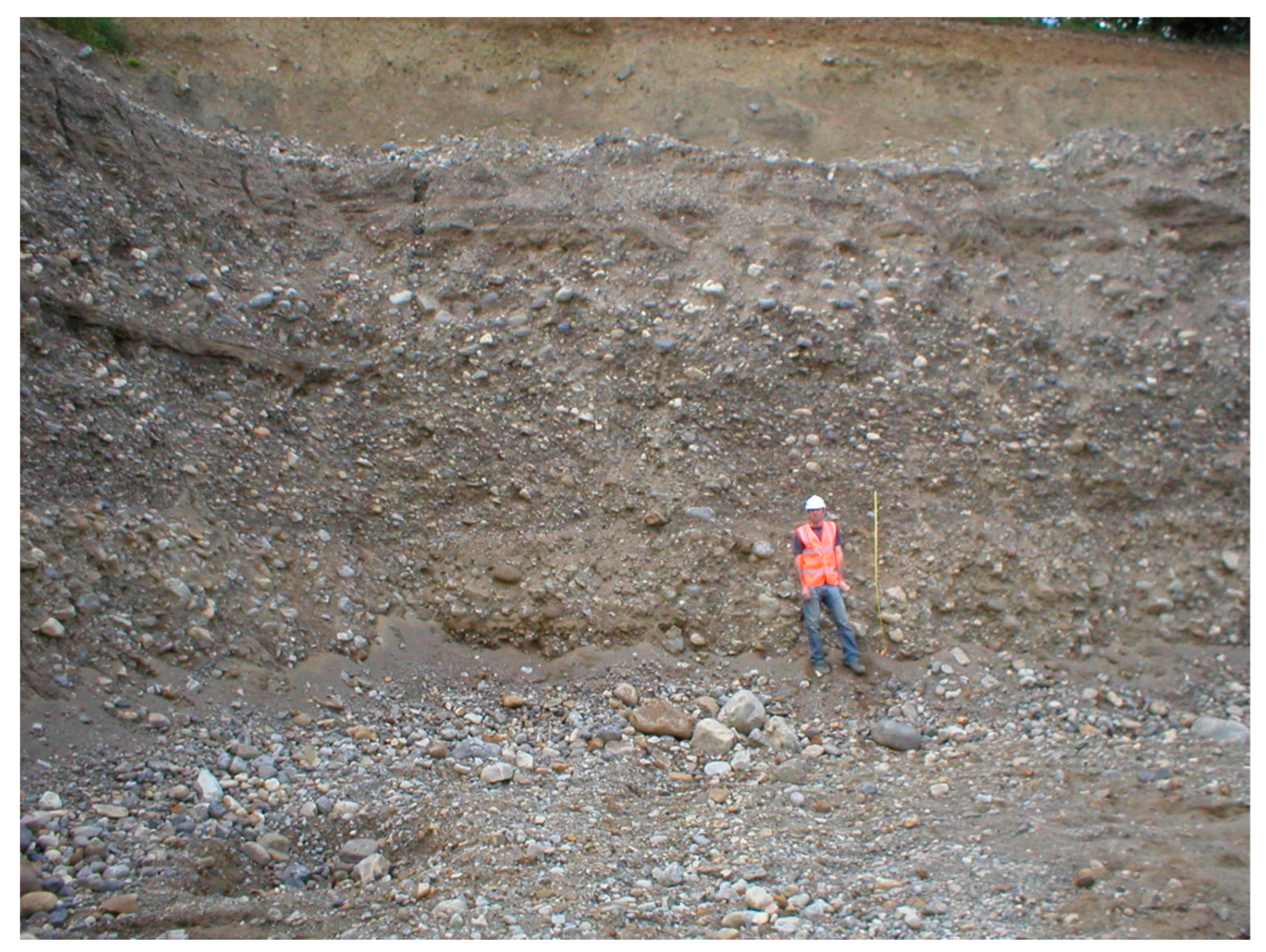
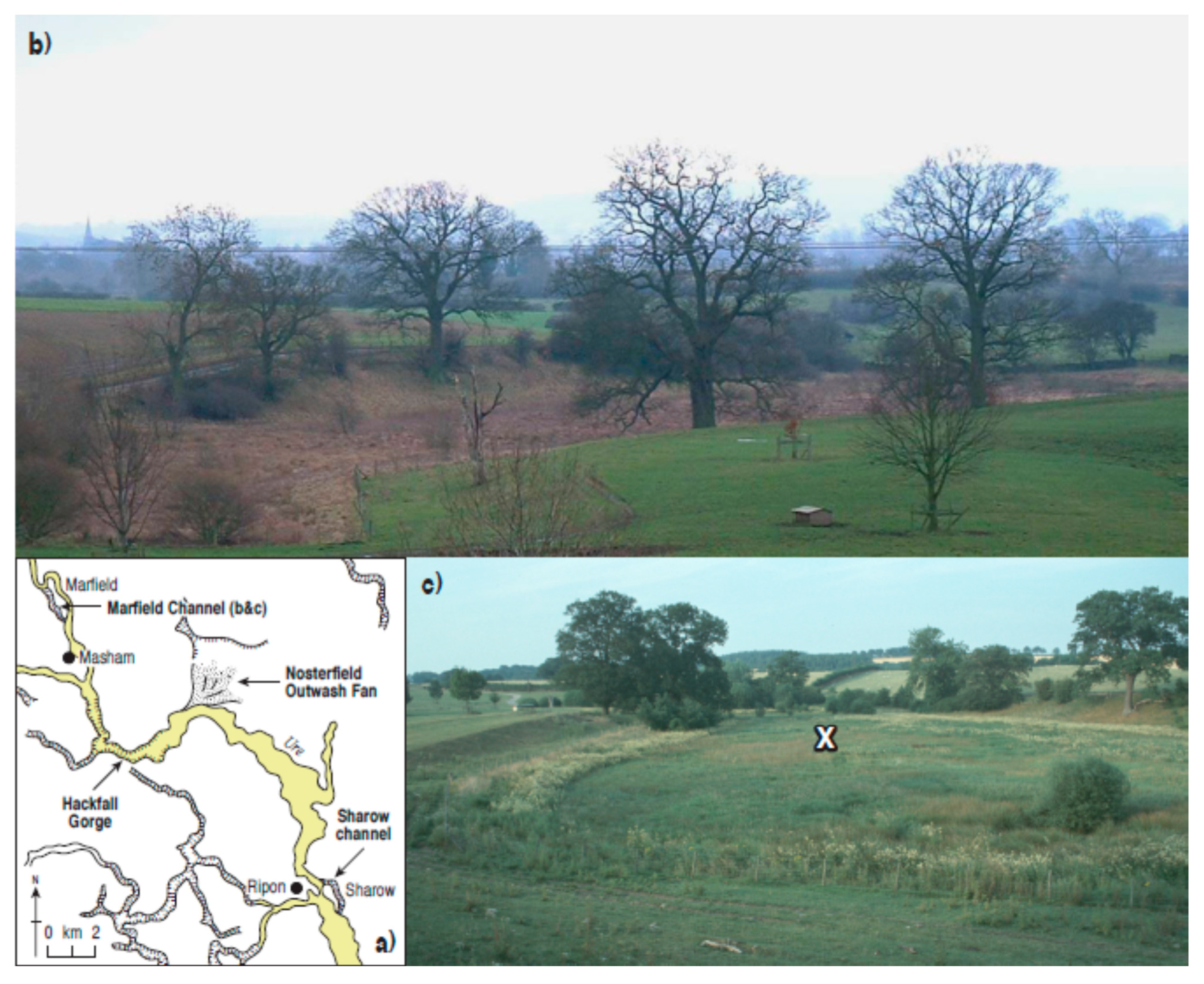
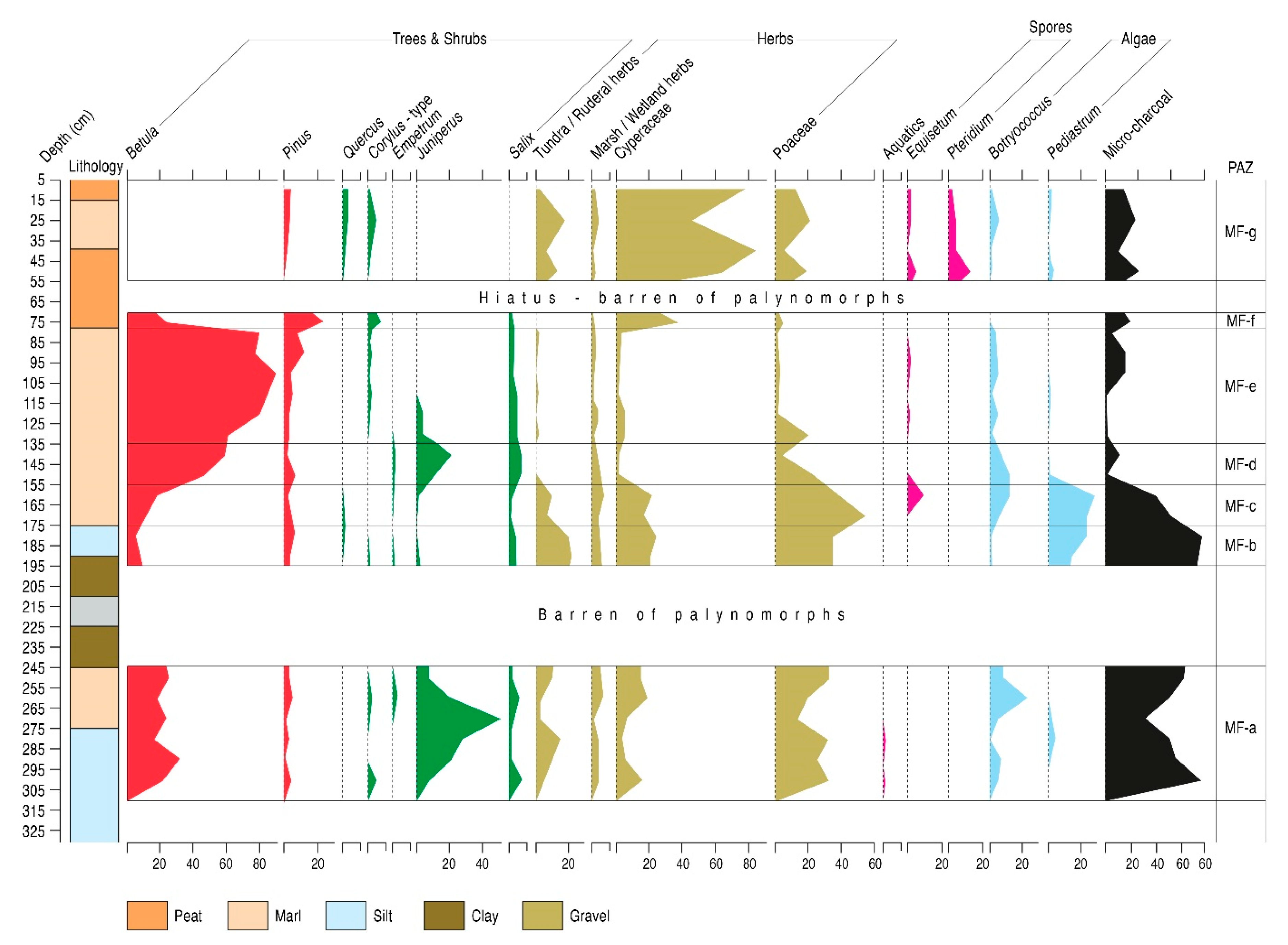
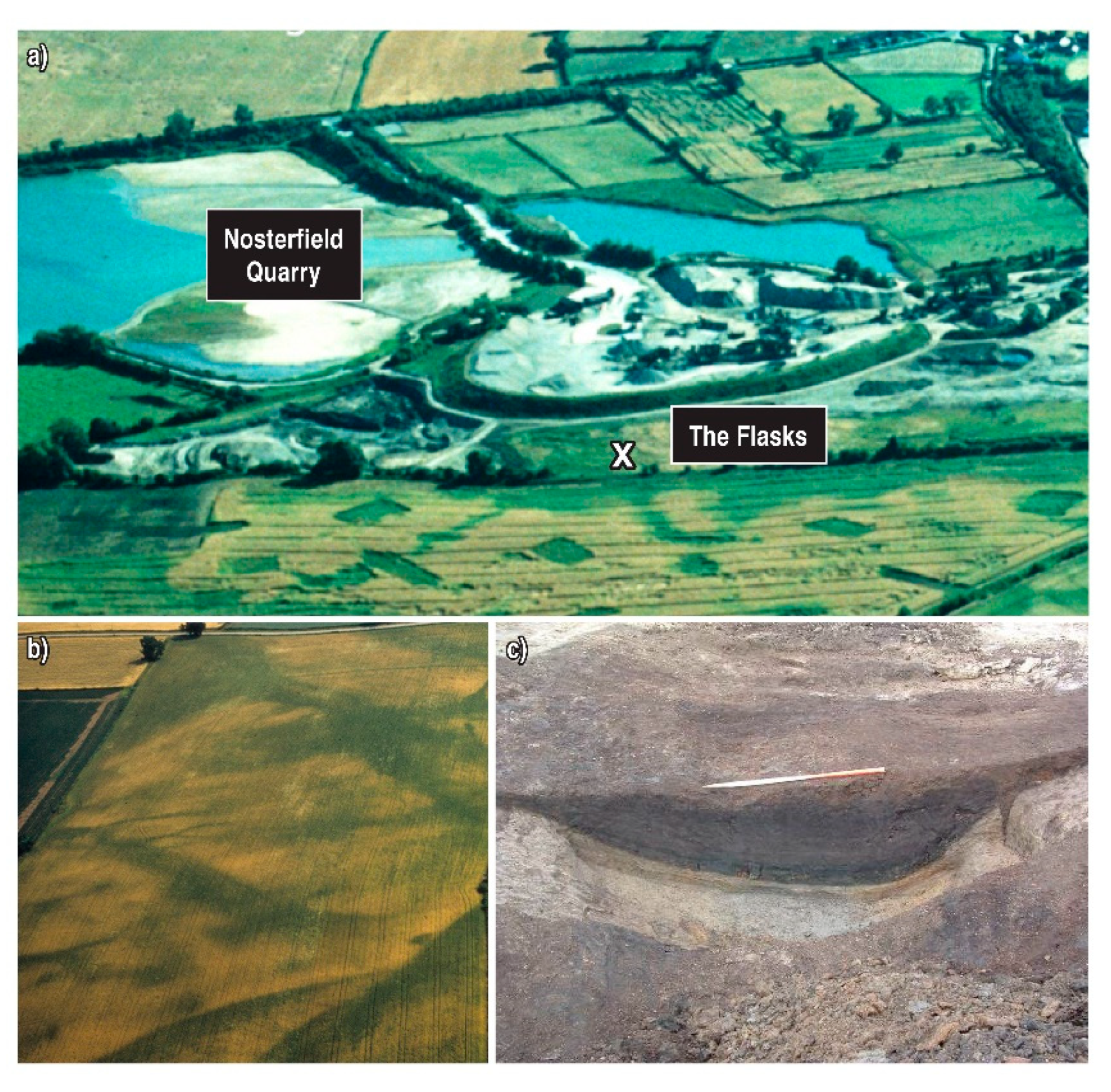
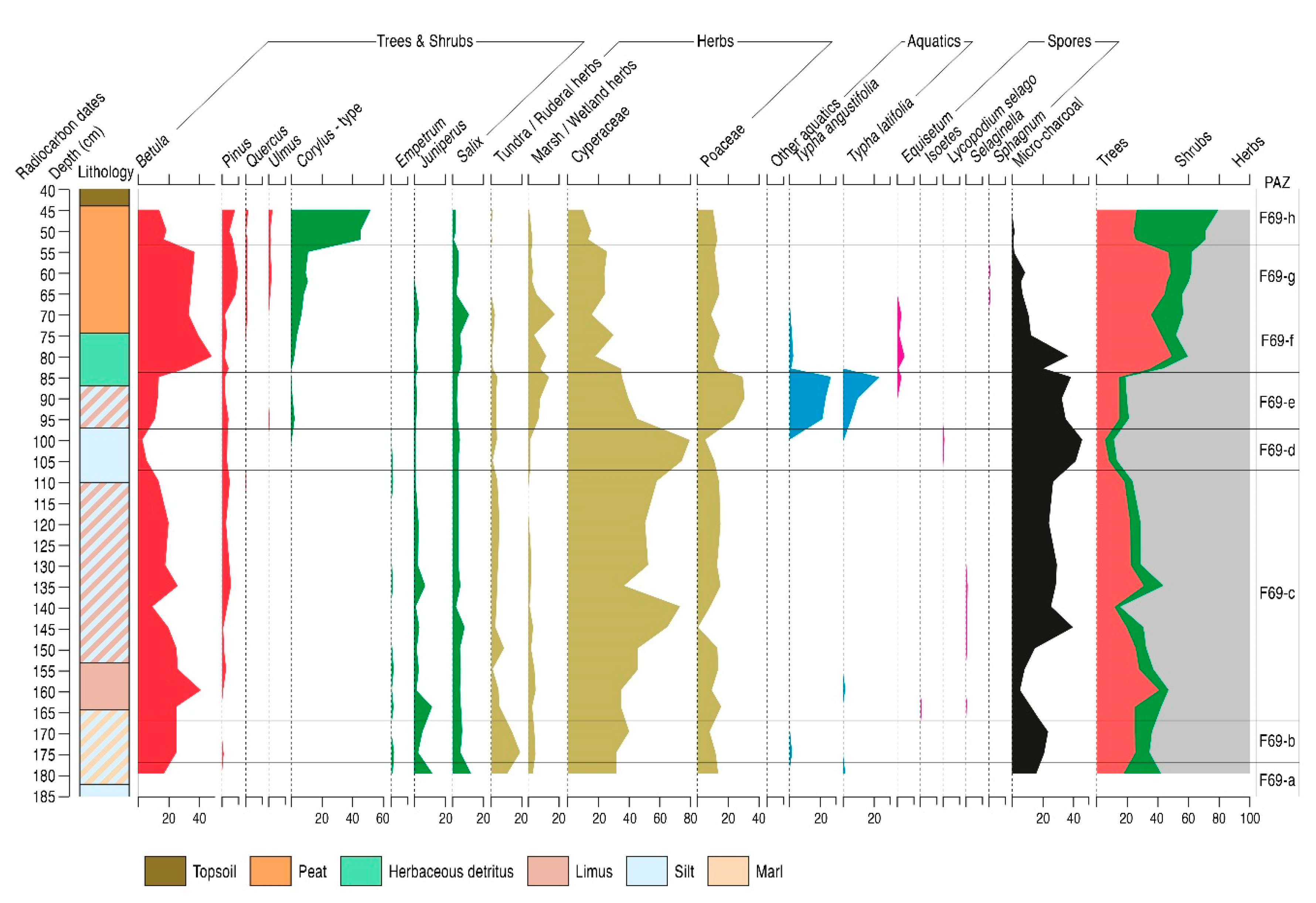
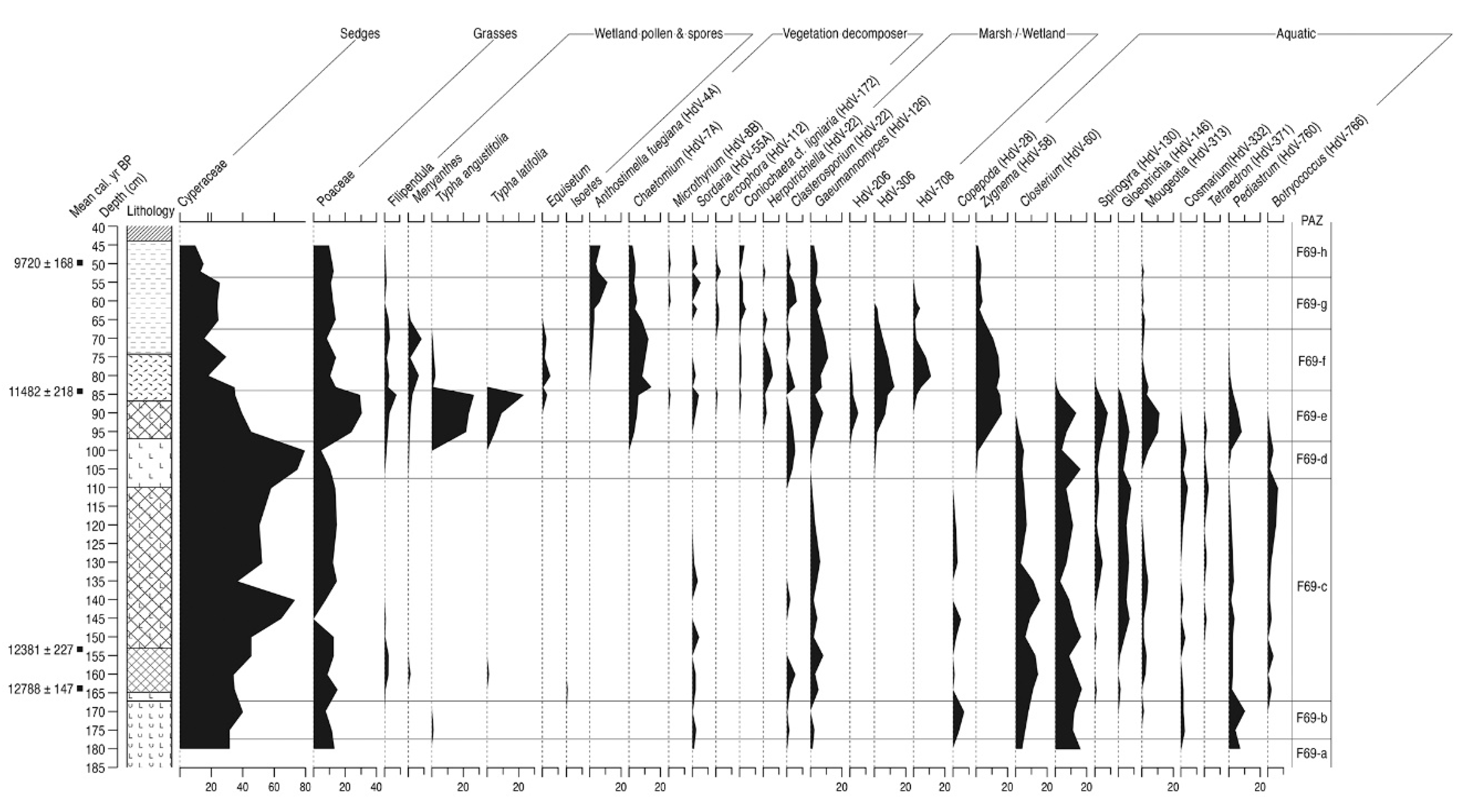

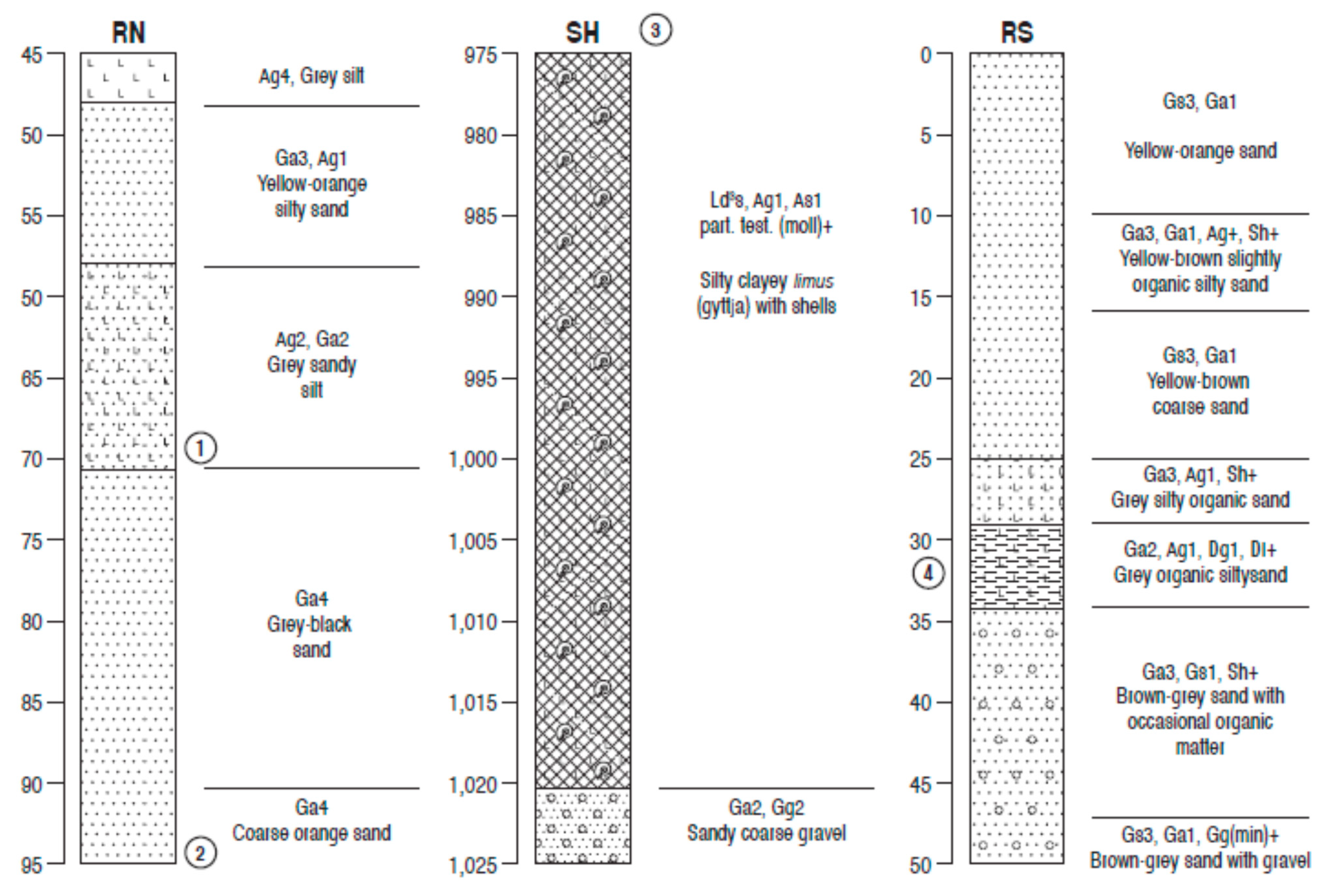
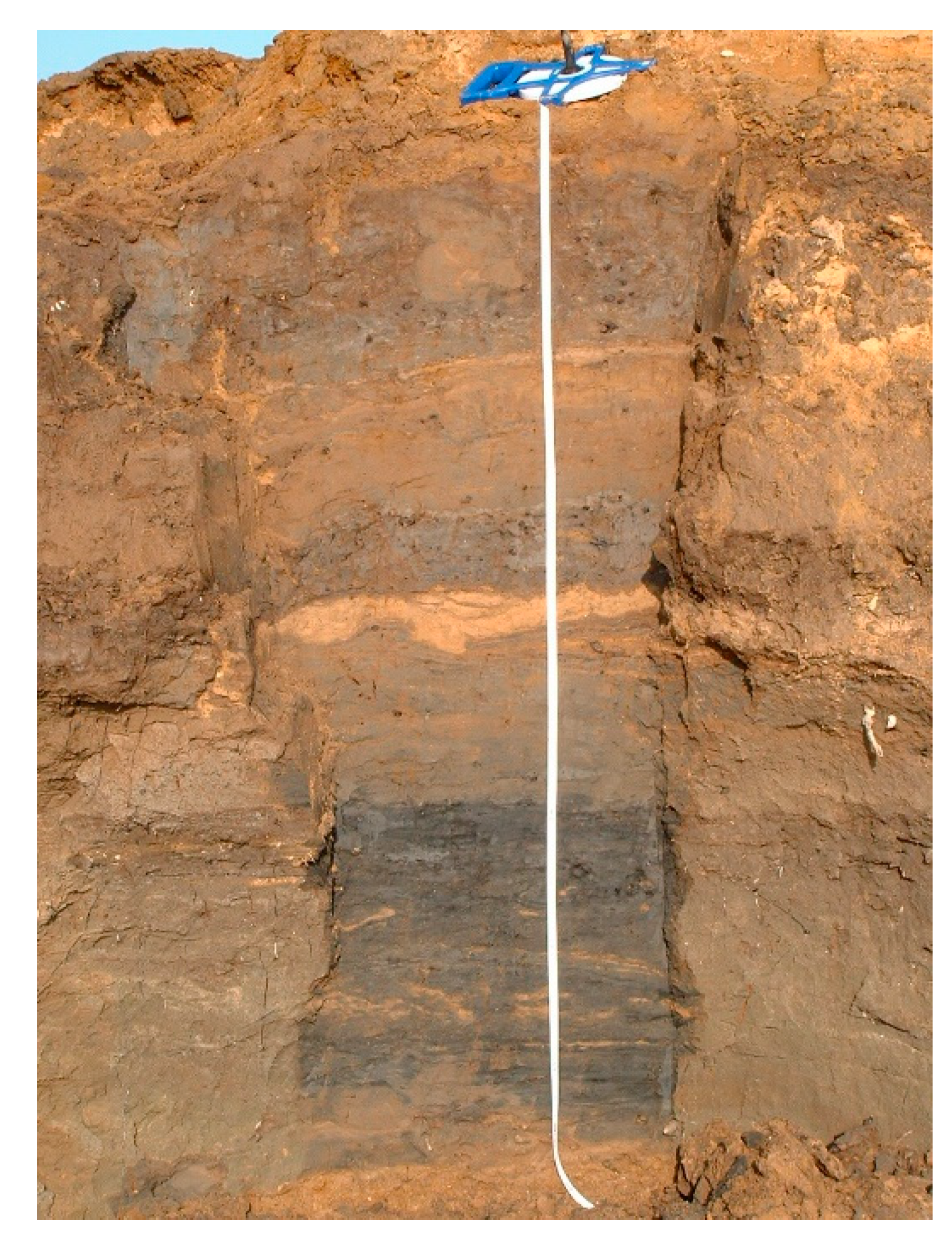
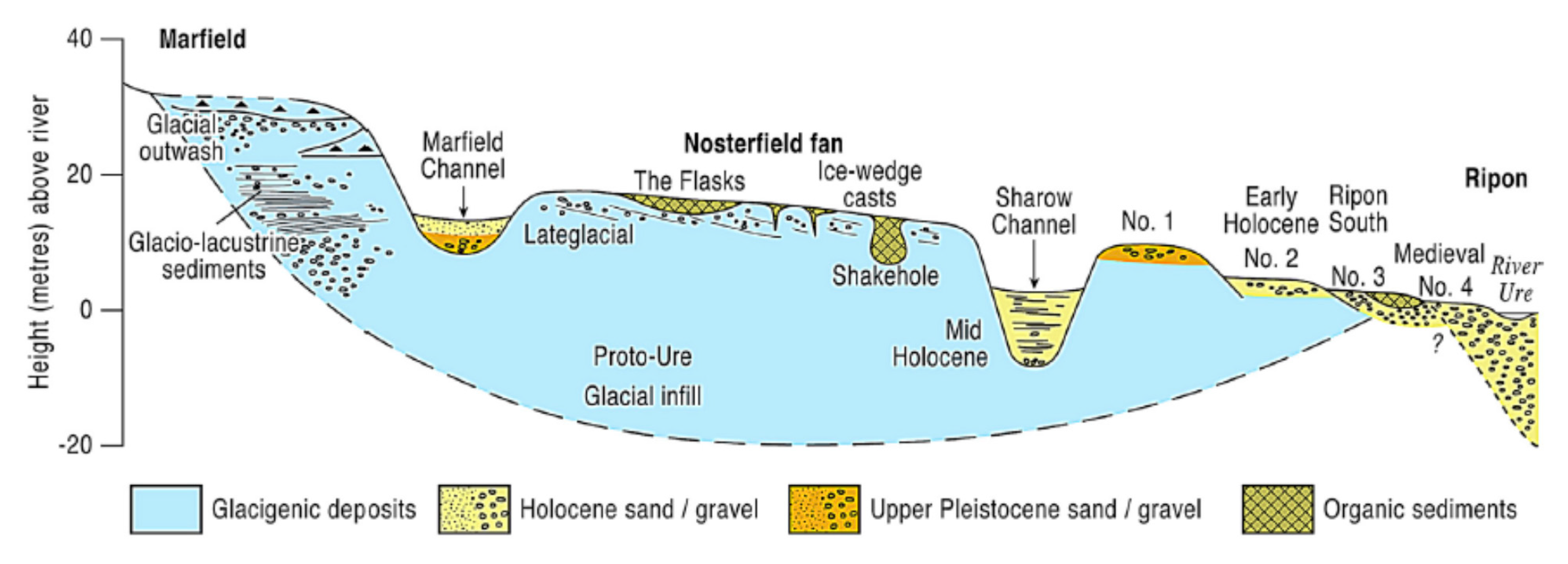
| Site Lab Code | Depth (cm) | Lab Code | 14C Date (yr BP) | Mean Age (cal. BP) | Age Range (cal. BP) |
|---|---|---|---|---|---|
| Flasks 69 | 49–50 | OxA-12960 | 8725 ± 45 | 9552–9888 | 9720 ± 168 |
| Flasks 69 | 83–85 | OxA-12932 | 9990 ± 45 | 11,264–11,701 | 11,482 ± 218 |
| Flasks 69 | 153–154 | OxA-12972 | 10,510 ± 55 | 12,154–12,608 | 12,381 ± 227 |
| Flasks 69 | 163–164 | OxA-12997 | 10,920 ± 45 | 12,641–12,935 | 12,788 ± 147 |
| Sharow Mires | 954 | SUERC-8881 | 3905 ± 35 | 4236–4426 | 4331 ± 95 |
| Ripon North | 69–70 | GrA-25377 | 2325 ± 50 | 2157–2488 | 2322 ± 165 |
| Ripon North | c.82 | Gu-5998 | 3900 ± 50 | 4155–4499 | 4327 ± 172 |
| Ripon South | 32 | OxA-12636 | 4011 ± 40 | 4411–4781 | 4596 ± 185 |
| Depth (cm) | Description |
|---|---|
| 0–16 | Amorphous, slightly silty organic material |
| Sh4, Ag+, nig.4, strf.0, elas.0, sicc.2 | |
| 16–39 | Orange brown shell marl with organic inclusions and Turritellids (some whole) |
| Lc4, Sh+, test. (moll)+, part. test. (moll)+, nig.1, strf.0, elas.0, sicc.2, lim.sup.0 | |
| 39–66 | Brown silty humified peat with some clay |
| Sh3, Ag1, As+, nig.3, strf.0, elas.0, sicc.2, lim.sup.0 | |
| 66–79 | Black well-humified peat |
| Sh4, nig.4, strf.0, elas.0, sicc.2, lim.sup.0 | |
| 79–166 | Buff shell-marl with silt and organic material |
| Lc3, Ag1, part. test. (moll)+, Sh+, nig.1, strf.0, elas.0, sicc.2, lim.sup.0 | |
| 166–175 | Green-grey silty shell-marl with organic inclusions |
| Lc4, Ag+, part. test. (moll)+, Sh+, nig.1, strf.0, elas.0, sicc.2, lim.sup.0 | |
| 175–190 | Dark grey clayey silt with shells and some gravel |
| Ag4, As+, part. test. (moll)+, Gg(min.)+, nig.2, strf.0, elas.0, sicc.2, lim.sup.0 | |
| 190–210 | Grey clayey silt with shells and gravel |
| Ag3, As1, part. test. (moll)+, Gg(min.)+, nig.2, strf.0, elas.0, sicc.2, lim.sup.0 | |
| 210–225 | Gravel |
| Gg(min)4, nig.2, strf.0, elas.0, sicc.2, lim.sup.0 | |
| 225–246 | Clayey silt with small gravel |
| Ag2, As1, Gg(min)1, nig.2+, strf.0, elas.0, sicc.2, lim.sup.0 | |
| 246–276 | Buff sandy shell marl with occasional small gravel |
| Lc2, Ga2, part. test. (moll)+, Gg(min)+, nig.1, strf.0, elas.0, sicc.2, lim.sup.0 | |
| 276–308 | Dark grey clayey silt with shells and organic inclusions |
| Ag3, As1, part. test. (moll)+, Sh+, nig.2+, strf.0, elas.0, sicc.2, lim.sup.0 | |
| 308–329 | Dark grey clayey silt |
| Ag3, As1, nig.3, strf.0, elas.0, sicc.2, lim.sup.0 |
| Depth (cm) | Description |
|---|---|
| 0–45 | Topsoil |
| 45–75 | Crumbly humified amorphous peat. |
| Sh4, nig.4, strf.0, elas.0, sicc.3, lim.sup.0 | |
| 75–86 | Herbaceous detritus peat. Charcoal present from 80 to 85 cm. |
| Dh4, anth.+++, nig.3, strf.0, elas.0, sicc.2, lim.sup.0 | |
| 86–96 | Brown organic shelly silt with limus. |
| Ag3, Ld31, Sh+, part.test.(moll.)+, nig.2+, strf.0, elas.0, sicc.2, lim.sup.0 | |
| 96–110 | Grey-yellow silt clay. |
| As2, Ag2, nig.2, strf.0, elas.0, sicc.2, lim.sup.2 | |
| 110–153 | Grey clay silt with limus. |
| Ag2, As1, Ld31, nig.2+, strf.0, elas.0, sicc.2, lim.sup.0 | |
| 153–164 | Brown limus |
| Ld34, nig.2+, strf.0, elas.1, sicc.2, lim.sup.0 | |
| 164–166 | Grey silt clay. |
| As2, Ag2, nig.2, strf.0, elas.0, sicc.2, lim.sup.1 | |
| 166–200 | Grey-yellow silty shell marl. |
| Lc3, Ag1, part.test.(moll.)+, nig.2, strf.0, elas.0, sicc.2, lim.sup.0 | |
| 200–235 | Grey-yellow clay silt with sand. |
| Ag2, As2, Ga++, nig.2, strf.0, elas.0, sicc.2, lim.sup.1 |
| Site | Channel Altitude | Approximate Age cal. BP |
|---|---|---|
| Marfield Quarry | 120 | >13,850 |
| Marfield Channel | 100 | 13,850–13,500 |
| Hackfall Gorge top | 70 | >13,000 |
| Hackfall Gorge end | 30 | >13,000 |
| Nosterfield Fan | 40 | 13,000 |
| Ripon North | 27 | 5000–4500 |
| Sharow Mires | 17 | 4700–4200 |
| Ripon South | 16 | 4500–4000 |
Publisher’s Note: MDPI stays neutral with regard to jurisdictional claims in published maps and institutional affiliations. |
© 2021 by the authors. Licensee MDPI, Basel, Switzerland. This article is an open access article distributed under the terms and conditions of the Creative Commons Attribution (CC BY) license (http://creativecommons.org/licenses/by/4.0/).
Share and Cite
Innes, J.; Mitchell, W.; O’Brien, C.; Roberts, D.; Rutherford, M.; Bridgland, D. A Detailed Record of Deglacial and Early Post-Glacial Fluvial Evolution: The River Ure in North Yorkshire, UK. Quaternary 2021, 4, 9. https://0-doi-org.brum.beds.ac.uk/10.3390/quat4010009
Innes J, Mitchell W, O’Brien C, Roberts D, Rutherford M, Bridgland D. A Detailed Record of Deglacial and Early Post-Glacial Fluvial Evolution: The River Ure in North Yorkshire, UK. Quaternary. 2021; 4(1):9. https://0-doi-org.brum.beds.ac.uk/10.3390/quat4010009
Chicago/Turabian StyleInnes, James, Wishart Mitchell, Charlotte O’Brien, David Roberts, Mairead Rutherford, and David Bridgland. 2021. "A Detailed Record of Deglacial and Early Post-Glacial Fluvial Evolution: The River Ure in North Yorkshire, UK" Quaternary 4, no. 1: 9. https://0-doi-org.brum.beds.ac.uk/10.3390/quat4010009





